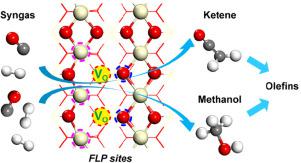当前位置:
X-MOL 学术
›
Chin. J. Catal.
›
论文详情
Our official English website, www.x-mol.net, welcomes your feedback! (Note: you will need to create a separate account there.)
Role of surface frustrated Lewis pairs on reduced CeO2(110) in direct conversion of syngas
Chinese Journal of Catalysis ( IF 16.5 ) Pub Date : 2020-12-01 , DOI: 10.1016/s1872-2067(20)63627-0 Zheng-Qing Huang , Teng-Hao Li , Bolun Yang , Chun-Ran Chang
Chinese Journal of Catalysis ( IF 16.5 ) Pub Date : 2020-12-01 , DOI: 10.1016/s1872-2067(20)63627-0 Zheng-Qing Huang , Teng-Hao Li , Bolun Yang , Chun-Ran Chang

|
Abstract Direct syngas conversion to light olefins on bifunctional oxide-zeolite (OX-ZEO) catalysts is of great interest to both academia and industry, but the role of oxygen vacancy (Vo) in metal oxides and whether the key intermediate in the reaction mechanism is ketene or methanol are still not well-understood. To address these two issues, we carry out a theoretical study of the syngas conversion on the typical reducible metal oxide, CeO2, using density functional theory calculations. Our results demonstrate that by forming frustrated Lewis pairs (FLPs), the VOs in CeO2 play a key role in the activation of H2 and CO. The activation of H2 on FLPs undergoes a heterolytic dissociative pathway with a tiny barrier of 0.01 eV, while CO is activated on FLPs by combining with the basic site (O atom) of FLPs to form CO22−. Four pathways for the conversion of syngas were explored on FLPs, two of which are prone to form ketene and the other two are inclined to produce methanol suggesting a compromise to resolve the debate about the key intermediates (ketene or methanol) in the experiments. Rate constant calculations showed that the route initiating with the coupling of two CO* into OCCO* and ending with the formation of ketene is the dominant pathway, with the neighboring FLPs playing an important role in this pathway. Overall, our study reveals the function of the surface FLPs in the activation of H2 and CO and the reaction mechanism for the production of ketene and methanol for the first time, providing novel insights into syngas conversion over OX-ZEO catalysts.
中文翻译:

表面受挫路易斯对还原 CeO2(110) 在合成气直接转化中的作用
摘要 在双功能氧化物-沸石 (OX-ZEO) 催化剂上将合成气直接转化为轻质烯烃是学术界和工业界都非常感兴趣的,但氧空位 (Vo) 在金属氧化物中的作用以及反应机理中的关键中间体是否是乙烯酮或甲醇仍然没有被很好地理解。为了解决这两个问题,我们使用密度泛函理论计算对典型的可还原金属氧化物 CeO2 的合成气转化进行了理论研究。我们的结果表明,通过形成受挫的路易斯对(FLPs),CeO2 中的 VOs 在 H2 和 CO 的活化中起关键作用。 FLPs 上 H2 的活化经历了一个具有 0.01 eV 微小屏障的异溶解离途径,而 CO通过与 FLPs 的基本位点(O 原子)结合形成 CO22-,在 FLPs 上被激活。在 FLP 上探索了四种合成气转化途径,其中两种易于形成乙烯酮,另两种倾向于产生甲醇,这表明在实验中解决了关于关键中间体(乙烯酮或甲醇)的争论。速率常数计算表明,以两个 CO* 耦合成 OCCO* 开始并以乙烯酮形成结束的途径是主要途径,相邻的 FLP 在该途径中起重要作用。总体而言,我们的研究首次揭示了表面 FLPs 在 H2 和 CO 活化中的作用以及生产乙烯酮和甲醇的反应机理,为 OX-ZEO 催化剂的合成气转化提供了新的见解。其中两个倾向于形成乙烯酮,另外两个倾向于产生甲醇,这表明可以通过折衷解决实验中关于关键中间体(乙烯酮或甲醇)的争论。速率常数计算表明,以两个 CO* 耦合成 OCCO* 开始并以乙烯酮形成结束的途径是主要途径,相邻的 FLP 在该途径中起重要作用。总体而言,我们的研究首次揭示了表面 FLPs 在 H2 和 CO 活化中的作用以及生产乙烯酮和甲醇的反应机理,为 OX-ZEO 催化剂的合成气转化提供了新的见解。其中两个倾向于形成乙烯酮,另外两个倾向于产生甲醇,这表明可以通过折衷解决实验中关于关键中间体(乙烯酮或甲醇)的争论。速率常数计算表明,以两个 CO* 耦合成 OCCO* 开始并以乙烯酮形成结束的途径是主要途径,相邻的 FLP 在该途径中起重要作用。总体而言,我们的研究首次揭示了表面 FLPs 在 H2 和 CO 活化中的作用以及生产乙烯酮和甲醇的反应机理,为 OX-ZEO 催化剂的合成气转化提供了新的见解。速率常数计算表明,以两个 CO* 耦合成 OCCO* 开始并以乙烯酮形成结束的途径是主要途径,相邻的 FLP 在该途径中起重要作用。总体而言,我们的研究首次揭示了表面 FLPs 在 H2 和 CO 活化中的作用以及生产乙烯酮和甲醇的反应机理,为 OX-ZEO 催化剂的合成气转化提供了新的见解。速率常数计算表明,以两个 CO* 耦合成 OCCO* 开始并以乙烯酮形成结束的途径是主要途径,相邻的 FLP 在该途径中起重要作用。总体而言,我们的研究首次揭示了表面 FLPs 在 H2 和 CO 活化中的作用以及生产乙烯酮和甲醇的反应机理,为 OX-ZEO 催化剂的合成气转化提供了新的见解。
更新日期:2020-12-01
中文翻译:

表面受挫路易斯对还原 CeO2(110) 在合成气直接转化中的作用
摘要 在双功能氧化物-沸石 (OX-ZEO) 催化剂上将合成气直接转化为轻质烯烃是学术界和工业界都非常感兴趣的,但氧空位 (Vo) 在金属氧化物中的作用以及反应机理中的关键中间体是否是乙烯酮或甲醇仍然没有被很好地理解。为了解决这两个问题,我们使用密度泛函理论计算对典型的可还原金属氧化物 CeO2 的合成气转化进行了理论研究。我们的结果表明,通过形成受挫的路易斯对(FLPs),CeO2 中的 VOs 在 H2 和 CO 的活化中起关键作用。 FLPs 上 H2 的活化经历了一个具有 0.01 eV 微小屏障的异溶解离途径,而 CO通过与 FLPs 的基本位点(O 原子)结合形成 CO22-,在 FLPs 上被激活。在 FLP 上探索了四种合成气转化途径,其中两种易于形成乙烯酮,另两种倾向于产生甲醇,这表明在实验中解决了关于关键中间体(乙烯酮或甲醇)的争论。速率常数计算表明,以两个 CO* 耦合成 OCCO* 开始并以乙烯酮形成结束的途径是主要途径,相邻的 FLP 在该途径中起重要作用。总体而言,我们的研究首次揭示了表面 FLPs 在 H2 和 CO 活化中的作用以及生产乙烯酮和甲醇的反应机理,为 OX-ZEO 催化剂的合成气转化提供了新的见解。其中两个倾向于形成乙烯酮,另外两个倾向于产生甲醇,这表明可以通过折衷解决实验中关于关键中间体(乙烯酮或甲醇)的争论。速率常数计算表明,以两个 CO* 耦合成 OCCO* 开始并以乙烯酮形成结束的途径是主要途径,相邻的 FLP 在该途径中起重要作用。总体而言,我们的研究首次揭示了表面 FLPs 在 H2 和 CO 活化中的作用以及生产乙烯酮和甲醇的反应机理,为 OX-ZEO 催化剂的合成气转化提供了新的见解。其中两个倾向于形成乙烯酮,另外两个倾向于产生甲醇,这表明可以通过折衷解决实验中关于关键中间体(乙烯酮或甲醇)的争论。速率常数计算表明,以两个 CO* 耦合成 OCCO* 开始并以乙烯酮形成结束的途径是主要途径,相邻的 FLP 在该途径中起重要作用。总体而言,我们的研究首次揭示了表面 FLPs 在 H2 和 CO 活化中的作用以及生产乙烯酮和甲醇的反应机理,为 OX-ZEO 催化剂的合成气转化提供了新的见解。速率常数计算表明,以两个 CO* 耦合成 OCCO* 开始并以乙烯酮形成结束的途径是主要途径,相邻的 FLP 在该途径中起重要作用。总体而言,我们的研究首次揭示了表面 FLPs 在 H2 和 CO 活化中的作用以及生产乙烯酮和甲醇的反应机理,为 OX-ZEO 催化剂的合成气转化提供了新的见解。速率常数计算表明,以两个 CO* 耦合成 OCCO* 开始并以乙烯酮形成结束的途径是主要途径,相邻的 FLP 在该途径中起重要作用。总体而言,我们的研究首次揭示了表面 FLPs 在 H2 和 CO 活化中的作用以及生产乙烯酮和甲醇的反应机理,为 OX-ZEO 催化剂的合成气转化提供了新的见解。

























 京公网安备 11010802027423号
京公网安备 11010802027423号